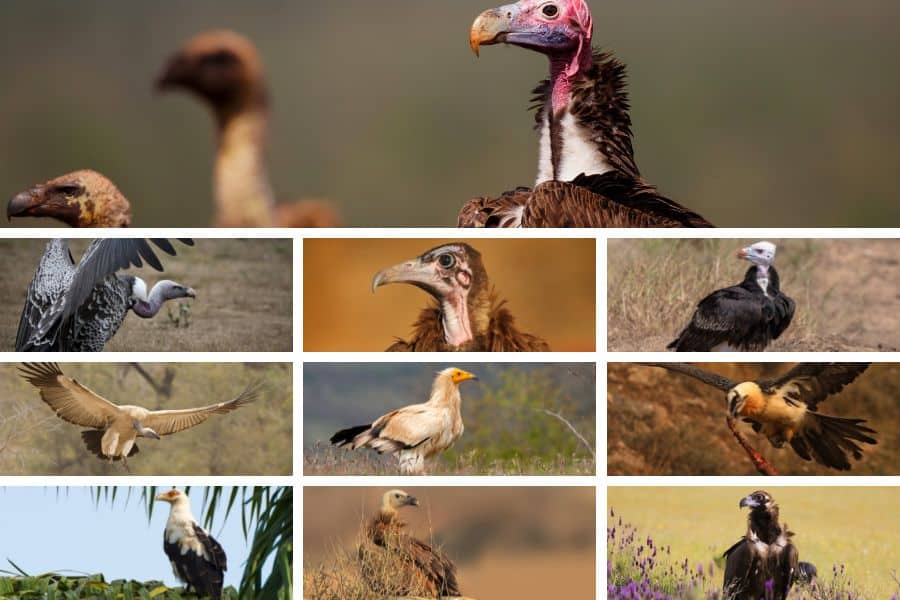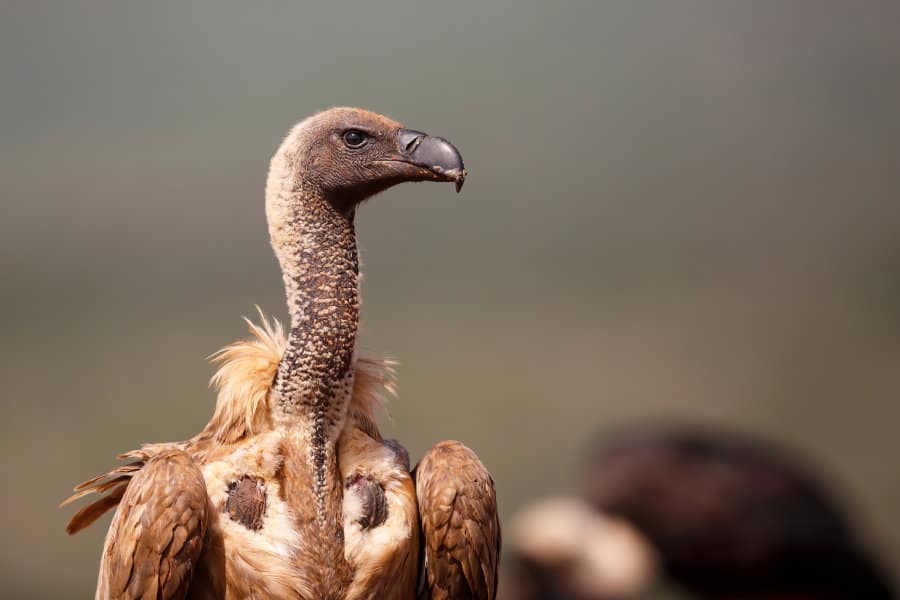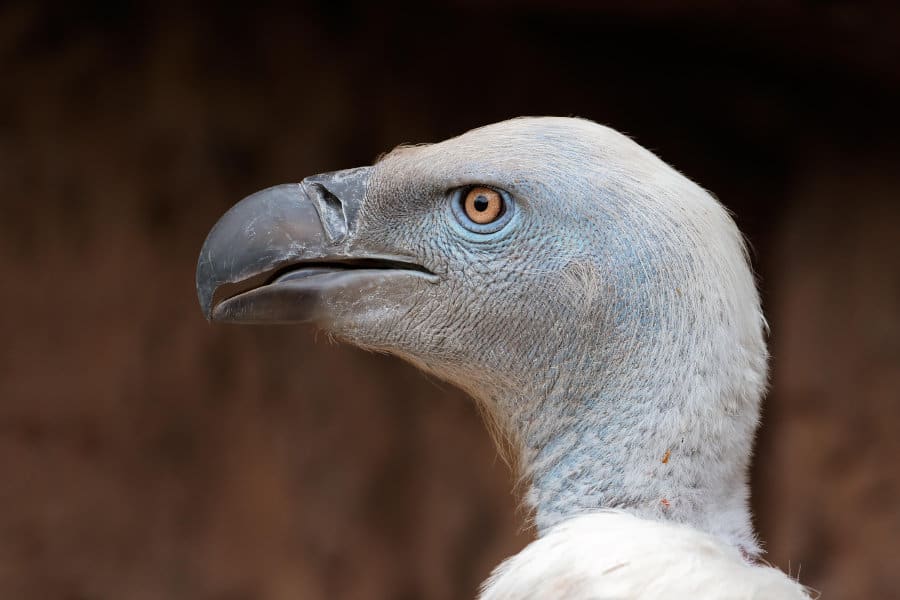Egyptian vultures, also called white scavenger vultures, are small Old World vultures and the only member of the Neophron genus. It is a striking raptor when seen soaring on thermals, recognizable by the contrasting patterns under its wings and a wedge-shaped tail.
Similar to the bearded vulture, this white feathered vulture rubs itself with soil rich in oxides. The habit adds color to the bird’s feathers and represents the vulture’s status, with older birds often displaying a deeper hue.
Read on to find out more about this incredible vulture, including its unique behavior towards ostrich and kori bustard eggs.
Neophron Percnopterus Species
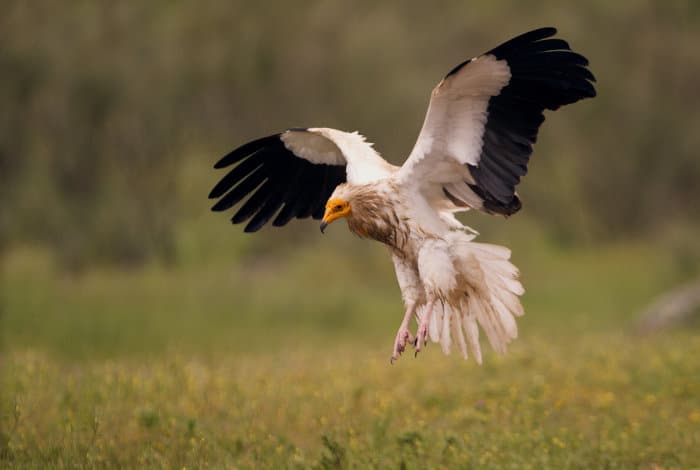
The Egyptian vulture, Neophron percnopterus, has three recognized subspecies. Neophron percnopterus percnopterus has the most extensive range with populations performing seasonal migration. Spain is home to almost half of the estimated 4000 European population.
The Neophron ginginianus lives predominantly in India and is the smallest of the three subspecies. Indian populations have seen a rapid decrease since 1999. Delhi recorded a population of 12000-15000 in the 1970s while recent estimations are closer to a few thousand.
Neophron majorensis is only found in the Canary Islands and is non-migratory. It displays a genetic difference from the other subspecies, with only about 130 individuals in existence.
Egyptian Vulture Diet
Scavengers by nature, Egyptian vultures feed on a range of food. They are capable of killing small animals, with wild rabbits making up a significant part of the diet of birds living in Spain. Insects, carrion, reptiles, vegetables, fish and even fruit make up the Egyptian vulture’s diet.
They have received the name “churretero” in Spain for the habit of eating feces. Young chicks rely on regurgitated food from both parents. From the age of three months, the chicks are able to leave the nest and continue to rely on their parents for another month.
When arriving at a carcass the Egyptian vulture gives way to larger raptors and scavengers. It waits on the perimeter until the larger species leave. They also feed on the eggs of ostriches and kori bustards by using tools to gain access to the yolk.
Where Do Egyptian Vultures Live?
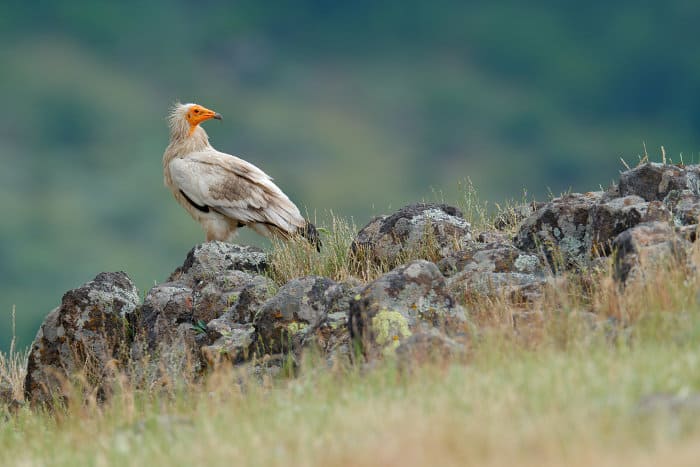
Egyptian vultures can travel long distances. They travel in southern Europe, northern Africa, and east to western parts of southern Asia. Most of the European vultures migrate to Africa in the winter. The species has bred as far south as the Wild Coast in South Africa.
The birds avoid crossing large bodies of water. Egyptian vultures born in Italy will typically cross through Sicily, Marettimo, Pantelleria, and occasionally Malta on the way to Tunisia.
Vultures from the Iberian peninsula migrate over the strait of Gibraltar in the west or in the east along the Levant. Migratory populations breed in Algeria, Egypt, Libya, Morocco, Tunisia, southern Europe, Turkey, northern Iran, Pakistan, northern India, and Nepal.
Resident populations of Egyptian vultures exist in Algeria, Cameroon, Chad, Ethiopia, Kenya, Tanzania, Niger, and northern Sudan. A small population persists in Angola and Namibia.
The species has gone extinct in the region of South Africa, Lesotho, and Swaziland.
Egyptian Vulture Habitat
The Egyptian vulture nests mainly in mountainous terrain and favors rocky cliffs. The species can nest at altitudes of 2000 meters in the Himalayas and an impressive 2300 meters in Armenia.
The nest is an untidy platform of twigs on a cliff edge or in the fork of a tree. Abandoned eagle nests are occasionally taken over by Egyptian vultures. Nests on the ground are unlikely – but do take place infrequently in the Indian and Canary Islands subspecies.
Due to decreases in habitat, the Egyptian vulture nests on electricity pylons and ledges of tall buildings in cities. It favors areas close to landfills. Often congregating in these areas despite usually being solitary birds.
Egyptian Vulture Size

The species is considerably smaller in size than other vultures in Europe. An adult male is between 58-70 cm in length, measured from the point of the beak to the end of its tail. The smaller N. p. ginginianus males measure 47-52 cm while females of the subspecies measure 52-55 centimeters.
It has a wingspan of 155 to 170 cm with female adults on average slightly larger than the males. The wingspan of an Egyptian vulture is about 2.7 times the length of its body.
The female Egyptian vulture is on average 10-15% heavier than males at 2,1 kg. The migratory birds from Spain weigh on average 1,9 kg while the subspecies from the Canary Islands weigh 2,4 kg.
Mating and Breeding: Gier Eagle
The Bible refers to the Egyptian vulture under the Hebrew name rachamah meaning “to love”. The name references the mating pairs habit of seldom separating. The word when translated into English is “gier-eagle” despite it being a vulture.
The Egyptian vulture is the only European vulture that migrates to Africa in winter. This behavior impacts the breeding period, with an average of two eggs laid in April or May.
Breeding pairs are monogamous and court at the beginning of spring. Soaring high into the air, either one or both birds make a steep dive – on occasion locking talons. After mating on land, the pair build a nest together and will often return to the same nest the following year.
Both the male and female vultures remain close to the nest, helping to incubate the eggs. The first egg hatches after 42 days – quickly followed by the second chick typically three to five days later. The chicks remain dependent on their parents for at least a month.
What Does the Egyptian Vulture Look Like?
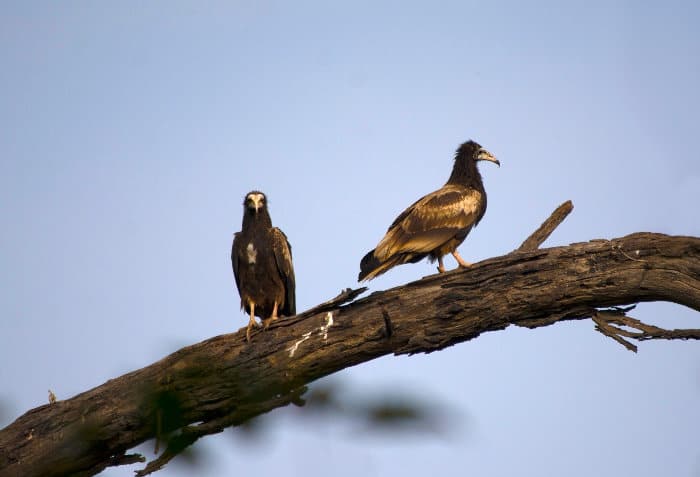
The three subspecies of Egyptian vulture have similar appearances. An adult has white plumage, with black feathers visible in the wings during flight. Rusty and brown shades do appear in the adult birds from areas with iron-rich soil.
It has a long beak with the top mandible shaped in a hook. Typically black in color, the beak of the Indian subspecies ginginianus can appear pale or yellow. The Egyptian vulture has a yellow face and breeding males have a deeper orange skin color than females.
Young birds are darker in color. They appear black or brown with black and white patches before attaining adult plumage from 5 years of age.
Threats and Conservation
The Neophron percnopterus species appears on the IUCN Red List as endangered. The estimated population of between 12 000-38 000 is in decline mainly due to human interactions.
The disturbance of nests, poisoning, electrocution, food scarcity, and changes to habitat are the leading threats to the species. The rapid decline in Indian populations is mainly attributed to birds ingesting livestock carcasses that contain toxic levels of anti-inflammatory drugs.
Juveniles show a higher mortality rate while adult Egyptian vultures face very few predators. The European population is under threat from the illegal poisoning of carnivores. A decrease in wild hoofed animals and the over-grazing of livestock threatens the African populations.
Power lines are a significant cause of mortality, often occurring in the Canary Islands, Spain, and Sudan. The electric poles are likely to continue to pose a risk to populations of Egyptian vultures and other species unless insulated.
What are we doing to conserve the Egyptian vulture?
The implementation of monitoring programs and supplementary feeding can assist existing populations. In addition, campaigns against illegal poisoning through awareness of the species aim to reduce future deaths.
An international species action plan alongside the national action plans in France, Bulgaria, and Italy aims to assist existing populations. The study of juvenile movements through satellite tags has helped inform conservation efforts.
The addition of new data and an awareness of the threats towards the species has enabled scientists to advocate specific measures.
12 Interesting Egyptian Vulture Facts
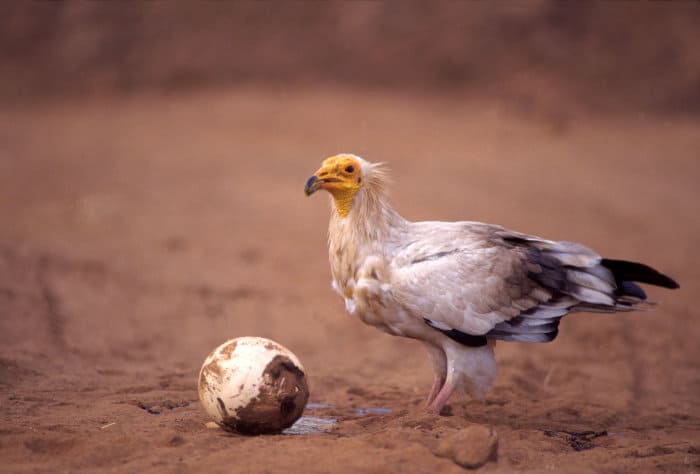
- Egyptian vultures use pebbles to break open eggs.
- The species use sticks to collect strands of wool to line its nest.
- Additional pairing does occur. The two males and the female help to raise the chicks.
- Egyptian vultures in captivity have lived up to 37 years old.
- If closely spaced chicks visit neighboring nests to obtain food.
- Vultures in Ancient Egypt were affectionately named ‘Pharaoh’s chicken’.
- It is the second smallest of all vulture species (behind the palm-nut vulture).
- The bare skin on its head helps to keep it clean when feeding.
- A kettle is the collective noun for a group of vultures in flight.
- A committee is the collective noun for a group of vultures on the ground.
- A wake is the collective noun for a group of vultures feeding.
- Egyptian vultures find carcasses exclusively by sight.
Let’s Head Off on Safari to See the Egyptian Vulture
As one of the smallest vulture species, Neophron percnopterus, still demands respect and admiration. Its use of tools is fascinating and makes this species worth visiting by booking a safari to Tanzania, Kenya, or Uganda.
Have you seen an Egyptian vulture? Share your encounter in the comments below.

